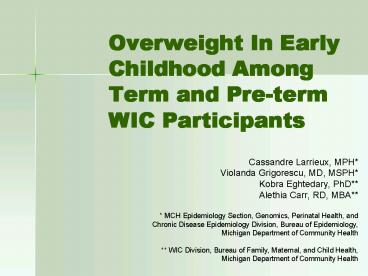Overweight In Early Childhood Among Term and Preterm WIC Participants - PowerPoint PPT Presentation
1 / 19
Title:
Overweight In Early Childhood Among Term and Preterm WIC Participants
Description:
Describe the prevalence of overweight in a group of WIC/Medicaid participants. ... in subsequent PedNSS were then linked to the corresponding mother/child dyad. ... – PowerPoint PPT presentation
Number of Views:55
Avg rating:3.0/5.0
Title: Overweight In Early Childhood Among Term and Preterm WIC Participants
1
Overweight In Early Childhood Among Term and
Pre-term WIC Participants
- Cassandre Larrieux, MPH
- Violanda Grigorescu, MD, MSPH
- Kobra Eghtedary, PhD
- Alethia Carr, RD, MBA
- MCH Epidemiology Section, Genomics,
Perinatal Health, and - Chronic Disease Epidemiology Division, Bureau of
Epidemiology, - Michigan Department of Community Health
- WIC Division, Bureau of Family, Maternal, and
Child Health, - Michigan Department of Community Health
2
Learning Objectives
- Describe the prevalence of overweight in a group
of WIC/Medicaid participants. - Describe the general health consequence of
childhood overweight. - Identify factors correlated with early childhood
overweight.
3
Background
- In general, overweight is a condition in which a
person has an excess amount of body fat. - This occurs when there is an imbalance of
calories consumed and calories expended in the
body - In adults, overweight is a BMI of 25 kg/m2 or
more. - Overweight and obesity are associated with an
increased risk of a variety of adverse health
conditions - diabetes,
- hypertension,
- heart disease,
- cerebrovascular disease,
- several forms of arthritis, and
- premature death
4
(No Transcript)
5
Background
- In the twenty years between NHANES I and NHANES
II, the prevalence of obesity had doubled in
children over the age of six years old. - The latest data for NHANES (1999-2002) shows that
16 (over 9 million) of children 6-19 are
overweight. - Also childhood and adolescent overweight is
- a strong predictor of adult overweight
- can further exacerbate adverse outcomes in
adulthood.
6
Background
- Several studies have identified critical periods
in the development of overweight in children - Gestation
- Infancy
- 3-6 years old, and
- Puberty
- Catch-up growth, experienced by pre-term and low
birthweight infants, is believed to contribute to
obesity - In addition, pre-term birth is also associated
with an increased risk of adult morbidity (e.g.
cardiovascular and metabolic disorders) and
mortality.
7
Study Question
- Does gestational age at birth have any impact on
child overweight?
8
Methods Data Source
- 2000 birth records, Pregnancy Nutritional
Surveillance System (PNSS), and the Pregnancy
Nutritional Surveillance System (PedNSS) data
were linked and mother/child pairs were identify.
The childs information in subsequent PedNSS were
then linked to the corresponding mother/child
dyad. - The resulting dataset had information for 7,624
children and their mothers from 2000-2003
9
Methods Study Population
- The study population was Medicaid participants
born in 2000 who were continuously enrolled in
Michigan WIC until they were three years old
(2003) and whose mother participated in WIC
prenatally. - Participants were grouped based on the BMI
percentile - BMI95th percentile for age and sex
- BMIlt95th percentile for age and sex
10
Demographics Childrens Characteristics
- 85.5 pf participants were either White or Black
- 47.3 were ever breastfed as infants
- 12.8 were born preterm
- 13.4 were overweight at 4 years old
11
Demographics Mothers Characteristics
- 55.0 of the mothers of the study participants
were between 20-29 years old - 83.9 has a HS education or less
- 30.7 had a pre-pregnancy BMI greater then 29
kg/m2 - 39.9 gained more weight then recommended for
their BMI
12
Methods Logistic Regression
- A logistic regression model was developed to
determine the adjusted odds ratio of overweight
at three years old for the gestational age. - Dependent Variable
- Overweight (at 3 yrs old)
- Independent variable of interest
- Gestational Age at Birth (term or pre-term)
- Potential confounders
- Childs Race/ethnicity
- Childs birthweight
- Childs ever breastfed status
- Mothers pre-pregnancy BMI
- Mothers weight gain during pregnancy
- Mothers Education
- Maternal Smoking
13
Methods Logistic Regression (continue)
- Software SAS v9.13
- Our reference groups were
- Non-Hispanic White child
- Born at term
- Born with a normal birthweight
- Mother had
- a HS diploma/GED
- normal BMI pre-pregnancy (19.8BMI26.0)
- Gained the recommended amount of weight for their
BMI
14
Regression Results Childs Characteristics
15
Regression Results Maternal Characteristics
16
Summary
- The odds of a child being overweight at three
years old was - 43 higher if the child was Hispanic
- 73 higher if the child was born with a high
birthweight - 32 lower of the child was Black
- 35 higher if the mother had less than a high
school education - 2x higher if the mother has a very high
pre-pregnancy BMI
17
Conclusions Discussion
- In this study, gestational age at birth was not
statistically significantly associated with
overweight at three years old, the results were
encouraging. - Modifiable maternal and infant factors were found
to be statistically significant predictors early
childhood overweight.
18
Limitations
- Length of study period
- No information about
- Paternal health and obesity
- Exclusive breastfeeding
- Feeding practices in later infancy and
toddler-hood - Maternal morbidity that may contribute to
childhood overweight (e.g. gestational diabetes) - Finding may not be generalizable to all children
- Cases were taken from a socioeconomically
vulnerable population
19
Thank You!
- Any questions?
20
PROC corr for birthweight and prematurity































